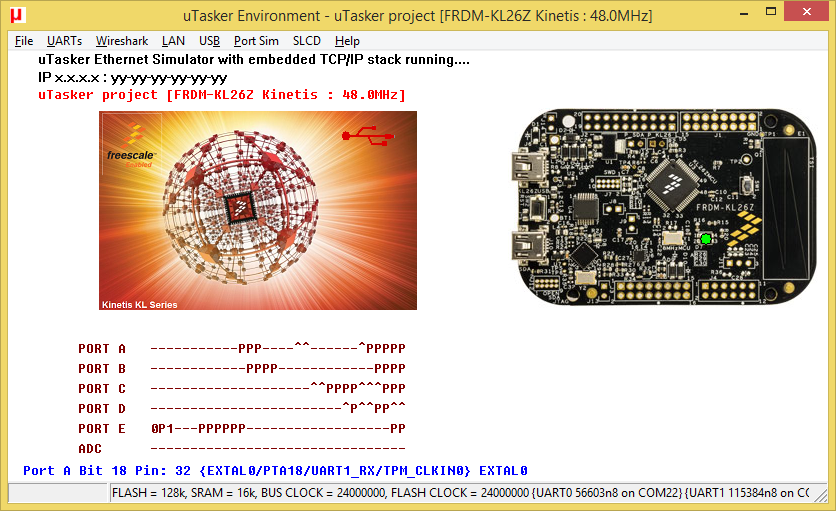FRDM-KL26Z

This NXP Freedom board is based on the KL26Z128VLH4 which is a 48MHz device from the ultra-low-power KL family with Cortex-M0+ core and USB. This KL26 device has 128k Flash and 16k SRAM and is in a 64 pin LQFP package, whereby the KL26 is also available in various other LQFP packages (32, 48, 80 pins) and its memory ranges from 32k ..256k Flash and 4k ..32k SRAM. There is an 8MHz crystal on the board for clocking the part.
Full details and documentation for this board can be obtained from the NXP web site: FRDM-KL26Z
To configure the µTasker project for this board simply enable the define FRDM_KL26Z in the project's config.h file. The compiler needs to be set to build for Cortex M0+ (and not Cortex M4) and the linker script KL_128_16.ld should be selected [KL_128_16_BM.ld for downloadable version] {the linker script extension may vary for different compilers, whereby *.ld is valid for GCC}
FRDM-KL26Z Binaries
Here are some binary files that can be loaded to the board. These were built using the µTasker applications (serial loader and V1.4 application)
and can be simply generated using the supported compilers/IDEs [these were built using GCC], built using different configuration options or modified to
suit specific requirements or hardware derived from this board :
- uTaskerSerialBoot_FRDM-KL26Z_KBOOT_HID_UART_MSD.bin KBOOT compatible USB-HID loader with composite USB-MSD loading, as well as KBOOT UART loading on UART 0 at 57'600 Baud [16.0k] allowing applications to be loaded at link address 0x8080 (using Freescale's KBOOT USB connection, or KBOOT UART at 57'600 Baud or USB-MSD when the board appears as upload hard disk). When operating, the green LED blinks at 5Hz. To force the loader reset the board with push button SW1 pressed. To disable the watchdog reset the board with with connector pin J1-8 pulled to GND. This can be loaded using the FRDM_KL26Z's USB-MSD (OpenSDA) boot loader. Note that the loader limits application sizes to 40k - it can be built without limits using the µTasker project.
-
uTaskerV1.4.8_BM_FRDM-KL26Z_8080.bin FRDM-KL26ZM application with command-line menu on the virtual COM connection (115'200 Baud) with various menu items (as well as on UART0),
including the ability to switch to USB-UART-0 bridge mode with end-to-end flow control. Output from the on-board accelerometer can be viewed in the I2C menu. Low power modes can be set in the application menu. The USB device is a composite USB-CDC with 3 CDC interfaces;
the first interface is connected to the command line menu but a USB-UART0 bridge can be commanded if required. The other two USB-CDC interfaces create dedicated USB-UART1 and USB-UART2 bridges.
Drivers that can be used for this device are available below. The processor runs at 48MHz [38.8k].
Linked to 0x8080, this binary image can be loaded with drag-and-drop onto the upload disk that appears when the serial loader is operating or using the KBOOT loader's USB or UART connections. When the application is running the green LED blinks at 2.5Hz. - uTaskerV1.4.8_FRDM-KL26Z.bin The same FRDM-KL26Z application as stand-alone software that can be loaded using the FRDM-KL26Z's USB-MSD (OpenSDA) boot loader [39.8k].
- uTaskerFreescaleMultiVirtualCOM.inf USB CDC installation file for 32-bit windows (usable for 1..6 USB-CDC composite interfaces).
- uTaskerFreescaleMultiVirtualCOM_64bit.inf USB CDC installation file for 32-bit windows (usable for 1..6 USB-CDC composite interfaces). See the following for a guide to installing unsigned drivers on Windows 8.1
TSI Slider
The following µTasker V1.4 application uses two channels of the TSI (Touch Sensor Interface) to realise a slider control on the FRDM-KL26Z (SUPPORT_KEY_SCAN and USE_SLIDER). When the slider area is touched the green LED stops blinking and the LED color is controlled by PWM outputs instead. When the slider position is moved the LED color changes from blue to red (color mixture according to the position). When the slider is no longer touched the color is held for one second before the LED starts blinking green again.The % slider position is shown on the debug output when the slider area is touched.
- uTaskerV1.4.10_FRDM-KL26Z_slider.bin stand-alone software that can be loaded using the FRDM-KL26Z's USB-MSD (OpenSDA) boot loader [29.7k]
Low Power - Very Low Power RUN
The following µTasker V1.4 application configures the KL26 to run directly from its internal 4MHz RC clock, setting the Bus/Flash speed to 800kHz in order to allow VLPR to be demonstrated. The UART speed is 19'200 Baud.The configuration and operation can be seen in the VIDEO "FRDM-KL26Z LOW POWER MODE".
- uTaskerV1.4.12_FRDM-KL26Z_LOW_POWER.bin stand-alone software that can be loaded using the FRDM-KL26Z's USB-MSD (OpenSDA) boot loader [68.6k]
µTasker V1.4 and FreeRTOS Operation
The following µTasker V1.4 application configures the KL26 to run a dual-operating system solution where the green LED is controlled by a 0.2s µTasker periodic task and the red LED is controlled by a 0.75s FreeRTOS task.A second FreeRTOS task will echo back input received on the OpenSDA VCOM UART connection (115'200 Baud) and a third FreeRTOS task will echo back USB-CDC data received on the KL26's USB FS OTG interface.
The µTasker drivers and USB stack are shared between µTasker and FreeRTOS applications with flexible pre-emptive and co-operative characterists for a reliable and low-footprint solution.
- uTaskerV1.4.12_FRDM-KL26Z_FreeRTOS_USB-CDC.bin stand-alone software that can be loaded using the FRDM-KL26Z's USB-MSD (OpenSDA) boot loader [42.2k]
Return to the Kinetis landing page
µTasker Kinetis FRDM-KL26Z support. Copyright (c) 2004..2019 M.J.Butcher Consulting